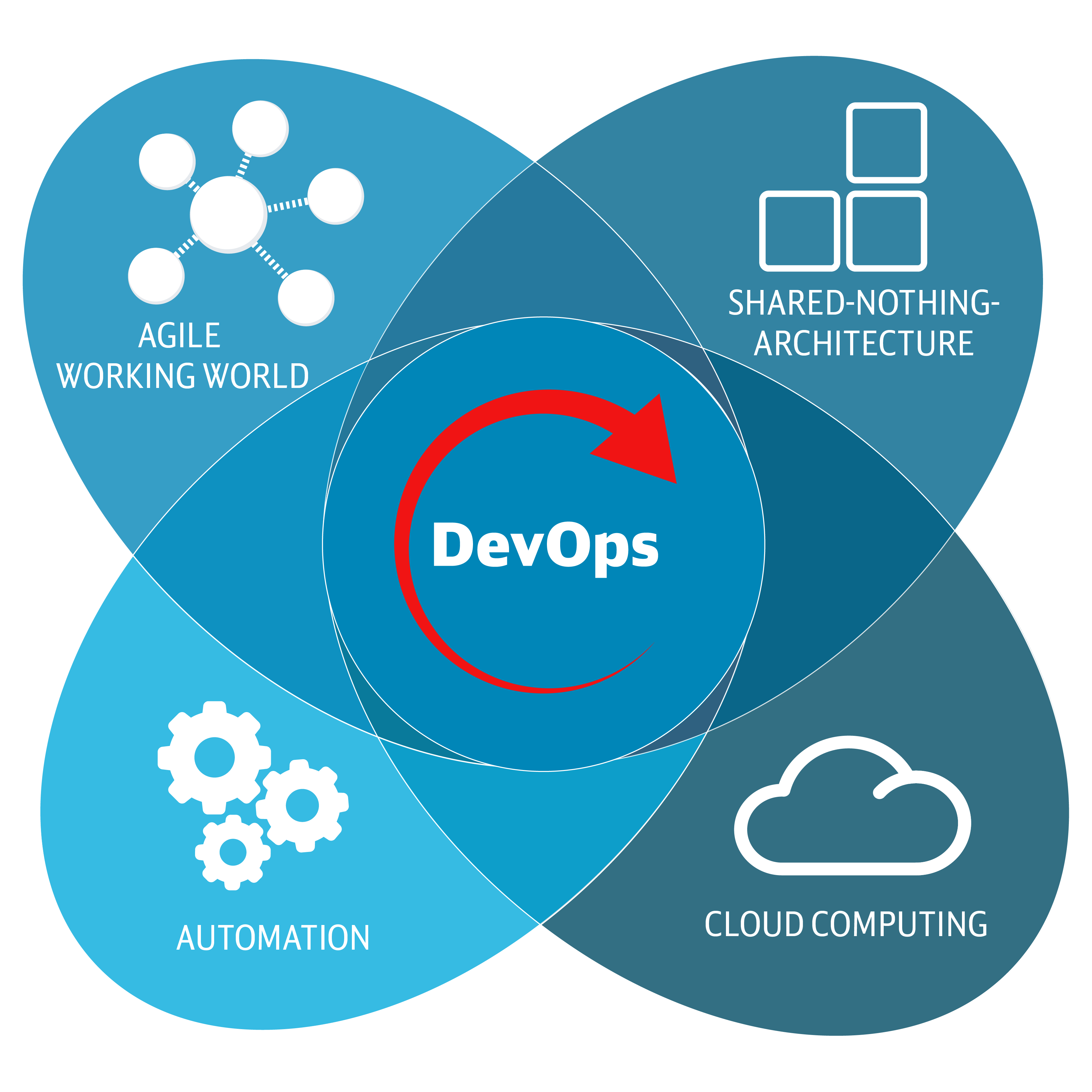Fully automatic railway track planning
Article: Successful development from project to product
09/2019 – Click&Ride can be used to automatically update the timetable for the German railway network. The continued development and operation of this innovative app using the DevOps approach is a glance at IT production of the future.
For many business segments of Deutsche Bahn – and especially those in competition for customers – it is essential to be able to create and improve digital solutions quickly. This is an important task for which there is a tool of choice: DevOps, with refers to the development and operation of IT projects from a single source, effectively creates an organizational separation between the specifications, development and operation. In addition, IT is closely networked with the teams of experts. “Collaboration within the project has always been close. Now, when working within the project, you don’t even notice anymore that employee A is from DB Netz and employee B belongs to DB Systel or another partner,” says Dr. Daniel Pöhle, Director of neXt Lab at DB Netz and Product Manager for Click&Ride. All participants profit from this type of broad collaboration. Developers gain an understanding of the functional benefits while rail experts expand their understanding of the technical interdependencies in IT. Above all, however, this leads to solutions that are designed to closely meet customer demands. Furthermore: Software releases reach customers quickly and with high quality. “In former times, deployments came out probably around twice a year. With the DevOps approach, we can publish updates at shorter intervals, and specific requests are available within a matter of days,” says Daniel Pöhle. Thus, this process supports the digital business of the entire Group.
"In former times, deployments came out probably around twice a year. With the DevOps approach, we can publish updates at shorter intervals, and specific requests are available within a matter of days."
That almost sounds like a promise. The advantages of the DevOps approach can be specifically illustrated using the Click&Ride app as an example. DB Netz is faced with the challenge that rail transport must remain competitive compared to road transport when it comes to freight. More trains need to run on the rails – and faster, too. The Click&Ride app enables freight operating companies (FOCs) to book a route utilization. Daniel Pöhle explains the process: “An FOC with its own locomotives and freight cars would like to transport a certain quantity of goods from A to B and needs an exact timetable for that route.” Using Click&Ride, which was developed as part of the promoted “Project to raise network capacity by digital means” project, timetables for the short-term rail freight transport are created automatically. FOCs can use it to request and book routes within minutes. The short time period that elapses until a reply is received can only be achieved with a completely automated route planning. “Before the advent of Click&Ride, it could take up to 72 hours for an FOC to obtain an offer,” says Daniel Pöhle. “With the new system, this has been reduced to no more than three minutes.”
Fully automatic process
This actually sounds quite easy – and that is exactly what it should be: easy to operate by customers and partners. UX designers were involved right from the very start. The result is an app that is self-explanatory and for which users do not require extensive training. The “magic” begins under the surface: An optimization core equipped with mathematical algorithms automatically generates timetables. “We have a large number of interfaces and systems that need to act in concert for this to happen. The process runs fully automatically in the background without requiring manual intervention,” explains Daniel Pöhle. “First the routine examines whether the train path order is plausible and valid. Then the automatic optimization core is executed that identifies a track with the available capacity. Then the offer is reserved for a certain period so that the customer has time to consider whether to accept it. At the same time, the track access charge is determined and displayed clearly in the app.” A number of different processes run when the reservation is booked, and several subsystems interact with each other. It goes without saying that such an IT system must be fast, highly flexible and scalable while also being reliable and stable.
Best prerequisite for a new production model
As this is a system designed for the future, development processes as applied in the past are out of the question. After the successful introduction of agile work processes, the DB Netz team decided to develop the application further and operate it based on the DevOps production model – and decided on DB Systel as a partner because the necessary prerequisites for the DevOps production model were already established there in the form of the ShapeIT cloud implementation program. For the implementation of Click&Ride, the DevOps team with the DB Enterprise Cloud delivers the necessary infrastructure, scalable productivity tools and technical excellence.
In projects such as Click&Ride, the agile working method has many advantages apart from shorter deployment intervals: DevOps enables low-risk development. The tools and software solutions used make it possible to focus on delivering results continuously. Thus, computing-intensive algorithms of the IT infrastructure can be flexibly scaled in the AWS cloud as needed. One does not need to rely on one’s own data centres for server capacity but can book it as needed on a pay-per-use basis, which keeps infrastructure costs down. Finally, the rate of innovation increases while the time-to-market for software updates and features is reduced.
Services for multiple applications
Software development relies on reusable services. “We couldn’t actually use any existing services for the algorithm and the automatic planning, and had to develop everything ourselves. However, we were able to use other services that had to be made available to the existing system, such as a service for customer data or information on track access charges,” says Dr. Martin Strunk, Project Manager 2D/d (DevOps) at DB Systel. On the other hand, it has already been possible to use many developments for Click&Ride for other scenarios, including the route search, the automated track design and the incoming order inspection. “In future, many services that we have developed for Click&Ride will also be deployed in other locations.”
This agile procedure and the combination of development and operation brought Click&Ride up to speed quickly. Nevertheless, DB Netz has not yet fully reached its goal for optimizing automatic track design. “The system is productive and can officially be used, but not all transport companies or routes in Germany have been approved yet,” says Daniel Pöhle. Click&Ride is still in the beta phase, which was started with five relatively small transport companies and for which a so-called beta network is defined on which these FOCs can typically place orders. “Until the end of the year, we will continue adding transport companies and routes,” Daniel Pöhle ensures. “Whenever things are running smoothly and stably, the team moves on to the next step. By now, new FOCs are generally being added at a rate of roughly every two weeks. The routine is already so stable and smooth that we can significantly raise the order volume after only four weeks.”
The human factor
These production methods are not only characterized by technical factors such as clouds, architecture or automation. DevOps is also a new kind of collaboration, both within the team and acoss DB Netz. Organisational limits break down while changed working methods and a new type of collaboration provide the teams with a rapid capacity to act. Furthermore: Each team member feels responsible for every process step, both in development and during operation. “Thanks to the DevOps approach, we have people who feel responsible for this product and service – and understand them fully, inside and out. “From the outset, this prevents agreement problems, which primarily occur when the “why” is not fully understood. In our team, everyone knows what it’s all about, what the service does and what you need it for.”
"Thanks to the DevOps approach, we have people who feel responsible for this product and service – and understand them fully, inside and out."

The results speak for themselves: The breakdown of the boundaries between development and operations leads to a greater rate of development and concomitant with that to an increase in efficiency of the DevOps team. The close cooperation within the team and the understanding generated for IT and functionalities create added value: All participants can identify with the application and evolve together with a clear focus on the optimal application for FOCs. Above all, however, this approach creates a forward-looking culture of trust and broad cooperation across business units at DB. DevOps also represents a paradigm shift. Wherever there is no longer a clear distinction between functional expertise and technical know-how, the classical structures are also no longer effective. This is apparent, for example, in the field of financing – and in the distribution of costs. Instead of the classic project approach, it is more important to sharpen the product approach. Just how this can be implemented is shown by the pioneering work of the DevOps team in the continued development of Click&Ride: What started as an innovative, agile software project was optimized as a product with DevOps and with the future in mind.



